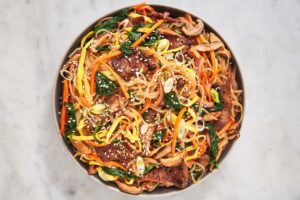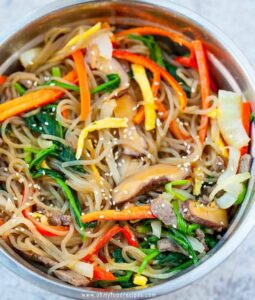Korean Japchae Recipe
Welcome to the wonderful world of Korean cuisine, where flavors dance and textures sing! Today, we’re diving headfirst into the enchanting realm of Korean Japchae Recipe, a stir-fried noodle dish that’s a symphony of tastes and a parade of colors. Japchae isn’t just food; it’s an experience, and it’s perfect for celebrations, family gatherings, or when you simply want to treat yourself to something extraordinary.
Korean Japchae Recipe Ingredients
Here’s your grocery list for an epic Korean Japchae Recipe adventure:
- 200g of Korean glass noodles (dangmyeon)
- 1/2 cup of soy sauce
- 2 tablespoons of sugar
- 2 cloves of garlic, minced
- 2 tablespoons of sesame oil
- 1 tablespoon of vegetable oil
- 1 medium-sized carrot, julienned
- 1 red bell pepper, thinly sliced ️
- 1 yellow bell pepper, thinly sliced
- 1 onion, thinly sliced
- 100g of spinach
- 100g of shiitake mushrooms, sliced
- 100g of beef or tofu (for a vegetarian option)
- Sesame seeds and green onions for garnish
Directions
Let’s embark on our culinary journey step by step:
- Cooking the Glass Noodles: Begin by boiling the Korean glass noodles (dangmyeon) following the instructions on the package. Once they’re done, drain and give them a refreshing cold-water rinse to prevent any unwanted stickiness.
- Preparing the Sauce: In a mixing bowl, combine the soy sauce, sugar, minced garlic, and sesame oil. Stir until that sugar completely dissolves into this umami-packed elixir of flavor. Set this heavenly sauce aside for later.
- Sautéing the Vegetables: In a large pan or wok, heat up the vegetable oil over medium-high heat. The sizzle of excitement begins as you add the sliced onions and carrots. Sauté them until they turn tender, then toss in the bell peppers, shiitake mushrooms, and spinach. Keep that sizzling symphony going until they’re cooked, yet still holding onto their delightful crunch. Remove this colorful medley and set it aside.
- Cooking the Meat or Tofu: If you’re on team meat, thinly slice it and give it a quick stir-fry until it’s no longer blushing pink. But if you’re dancing to the vegetarian beat, let tofu join the party and stir-fry it until it’s got a lovely tan.
- Combining Everything: Now, return those beautifully cooked glass noodles to the pan. Pour that enchanting sauce you prepared earlier all over them and let the noodles soak up those irresistible flavors. Next, bring back the sautéed veggies and your choice of meat or tofu to the party. Keep the wok fires alive for a few more minutes, allowing all the flavors to meld into pure deliciousness.
- Finishing Touches: Top it all off with a generous sprinkle of sesame seeds and a dash of freshly chopped green onions. It’s like adding a glittering crown to this majestic dish!
How to Prepare
Preparing Korean Japchae is all about coordination. While your noodles are bubbling away, get those veggies and proteins prepped and ready to shine. Having all your ingredients in place makes the stir-frying ballet smoother and more enjoyable. Remember to stir-fry each component separately before they unite in the ultimate flavor explosion.
Preparation Time ⏱️
The time you’ll spend preparing Korean Japchae Recipe varies depending on your kitchen prowess, but on average, you’ll be feasting in about 30-40 minutes from start to finish. ⏳
Nutritional Values
Let’s break down the nourishment this culinary masterpiece brings:
- Calories: 350 kcal
- Protein: 10g
- Carbohydrates: 45g
- Dietary Fiber: 3g
- Sugars: 6g
- Fat: 14g
- Saturated Fat: 2g
- Cholesterol: 20mg
- Sodium: 800mg
- Potassium: 400mg
Storage Conditions
Korean Japchae shines brightest when it’s fresh, but if you find yourself with leftovers, give them a cozy home in an airtight container in your refrigerator. Stored with love, it can stay delectable for 2-3 days. Reheating it is a breeze; just use a pan or microwave, adding a splash of water if needed to keep it succulent. ️
Korean Japchae Recipe FAQ ♀️♂️
Q1: Can I use other types of noodles for Japchae? A1: While Korean glass noodles (dangmyeon) are the traditional stars, don’t be afraid to explore with sweet potato starch noodles or rice noodles for a unique twist!
Q2: Is Japchae gluten-free? A2: Absolutely! Make it gluten-free by using tamari or gluten-free soy sauce. Now, everyone can enjoy the flavor fiesta!
Q3: Can I make Japchae in advance for a party? A3: Yes, you can. Prep the components ahead and stir-fry them just before your gathering for maximum freshness and flavor.
Q4: Can I omit the meat for a vegetarian version? A4: Of course! If you’re all about that veggie life, simply skip the meat and use tofu or go all-in with extra veggies. The choice is yours!
Q5: Can I make Japchae spicy? A5: Absolutely! Add a dash of Korean red pepper flakes (gochugaru) or your favorite hot sauce to turn up the heat. ️
Q6: What can I serve with Japchae? A6: Japchae is a harmonious companion to other Korean delights like bulgogi or kimchi. It also makes a fabulous sidekick to a variety of dishes.
Q7: Can I freeze Japchae for later? A7: While fresh is best, you can freeze Japchae in an airtight container for up to a month. Defrost and reheat when you’re ready to relive the magic! ❄️️
In conclusion, Korean Japchae Recipe is more than a dish; it’s a culinary masterpiece that’ll take your taste buds on a thrilling ride. Whether you’re a die-hard Korean cuisine enthusiast or just starting to explore, this recipe offers a mesmerizing flavor journey. Feel free to experiment, make it your own, and savor the vibrant, mouthwatering world of Korea’s cherished Japchae. Enjoy every bite, and happy cooking!





Leave a Reply